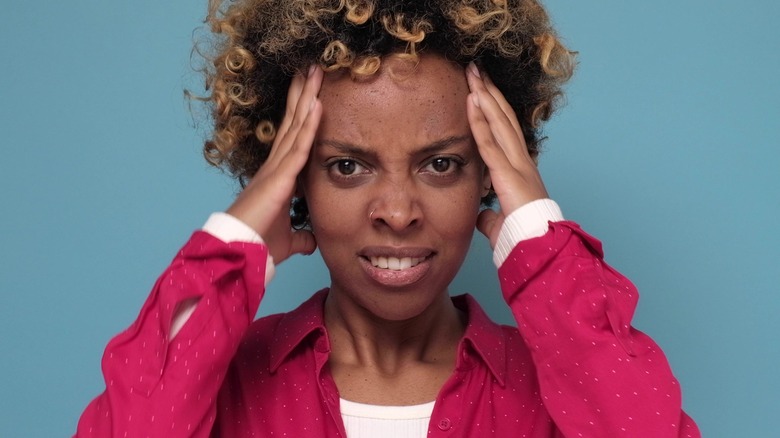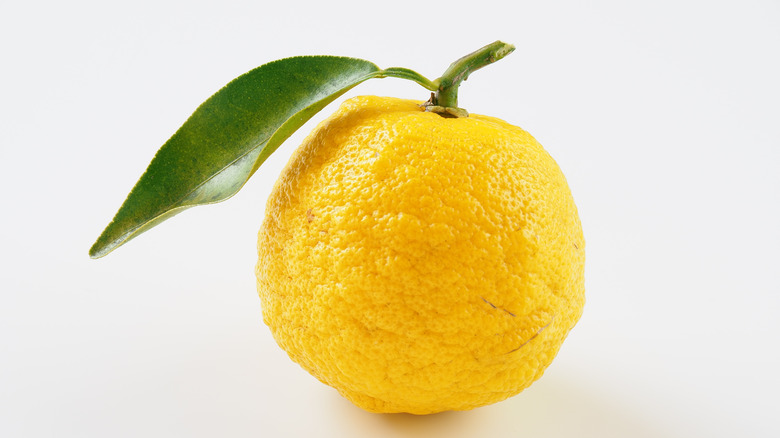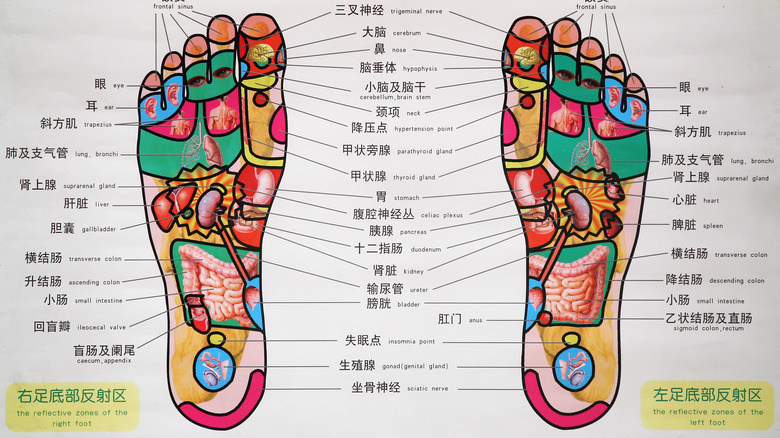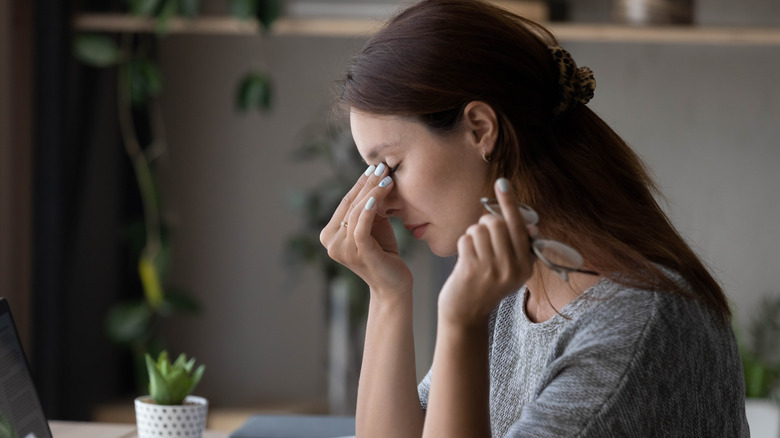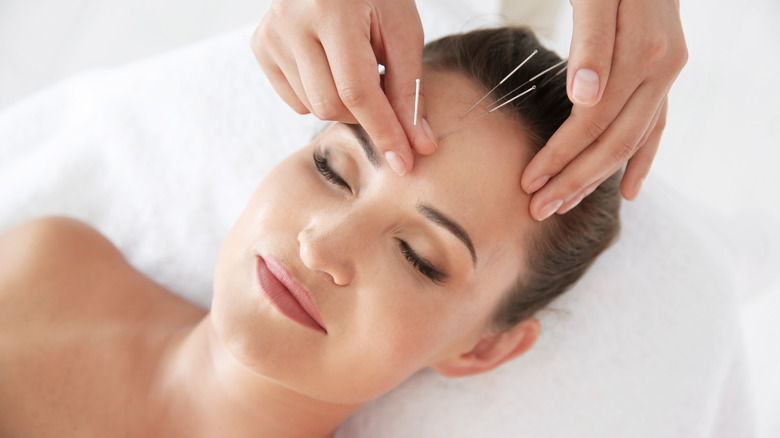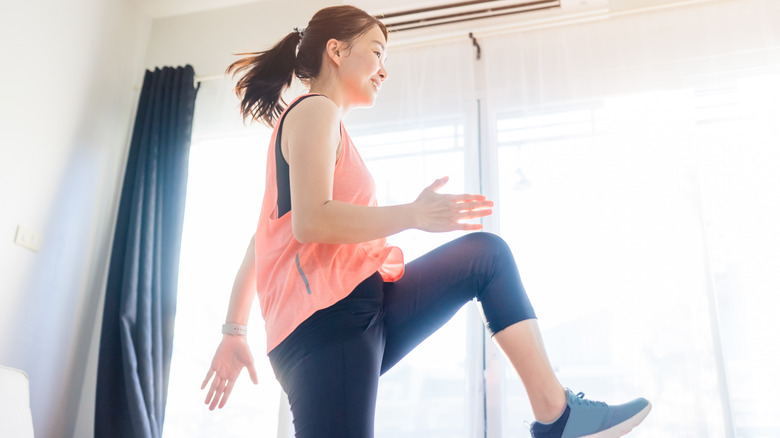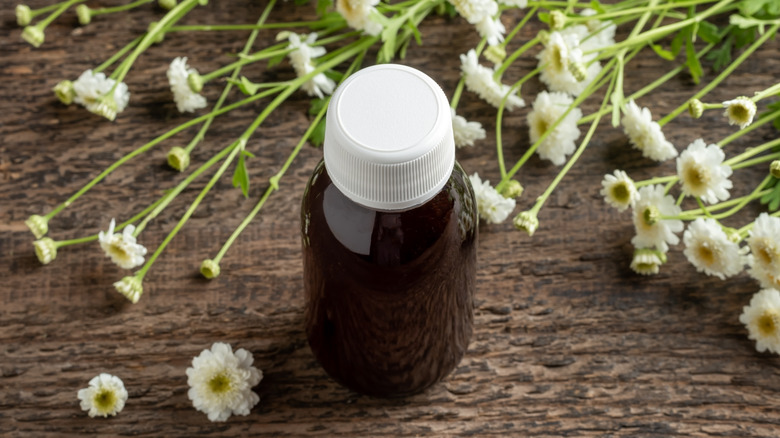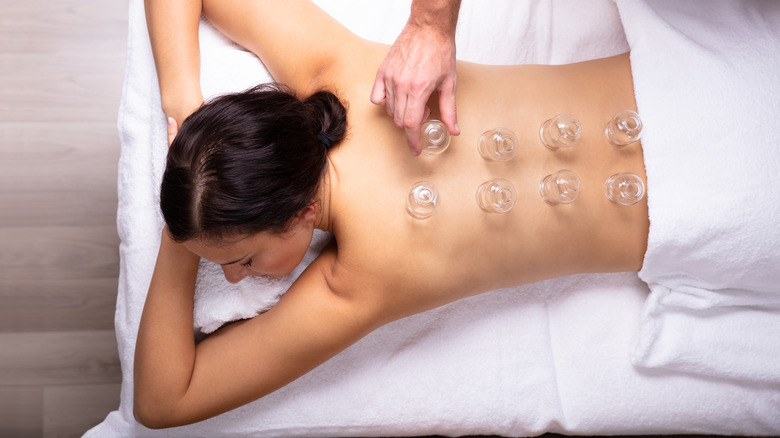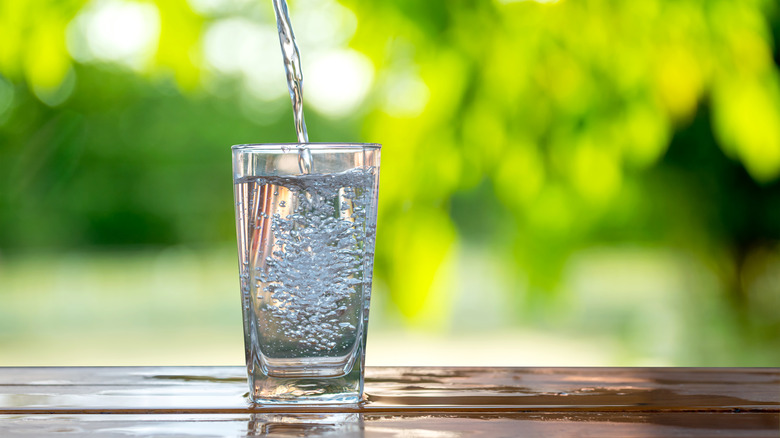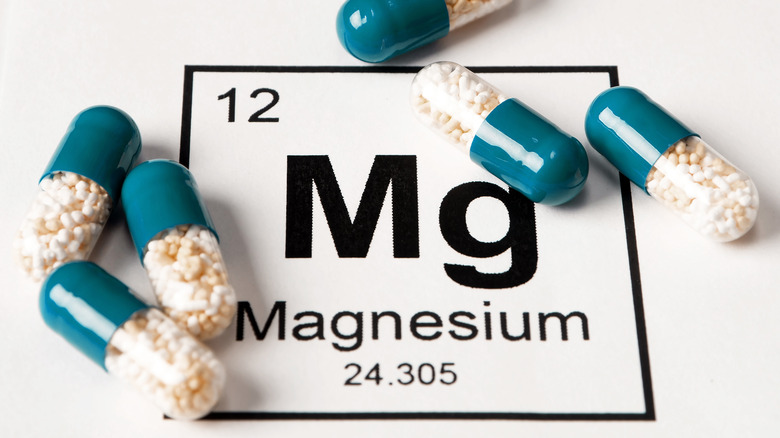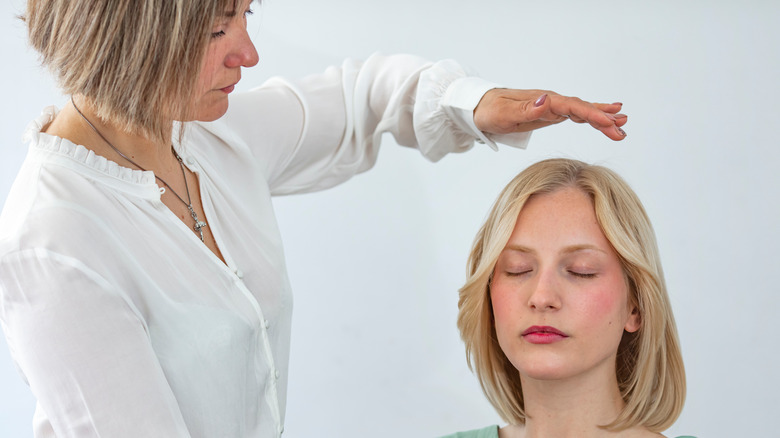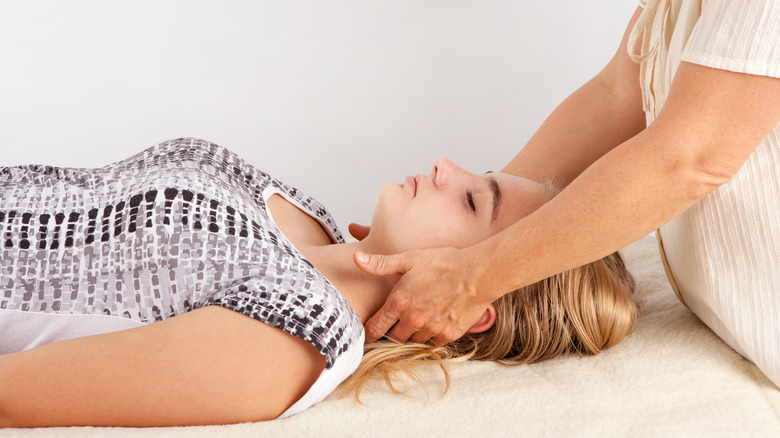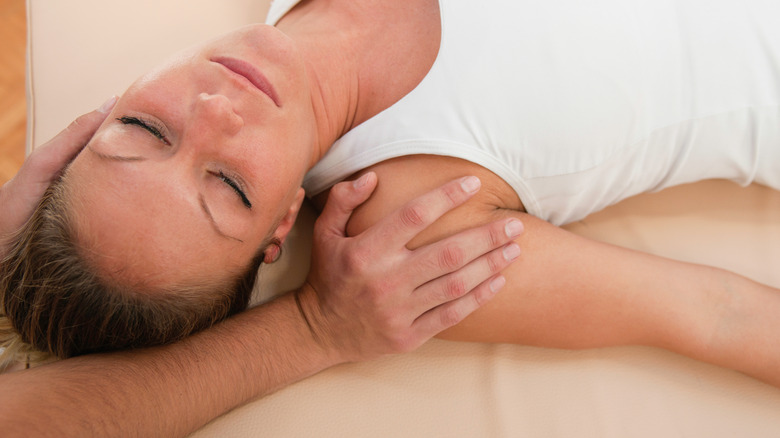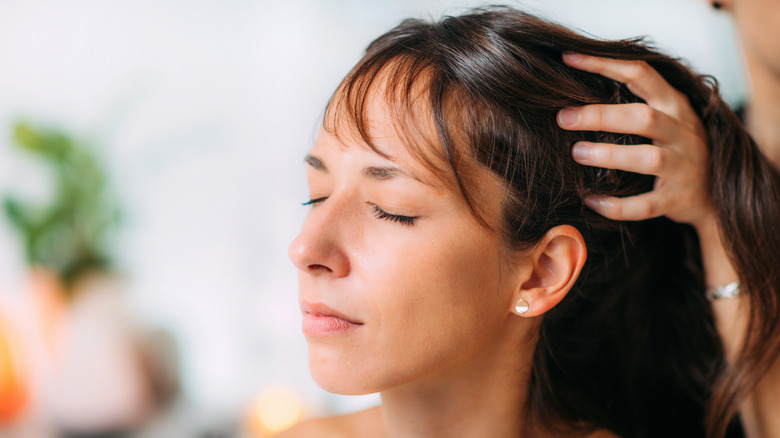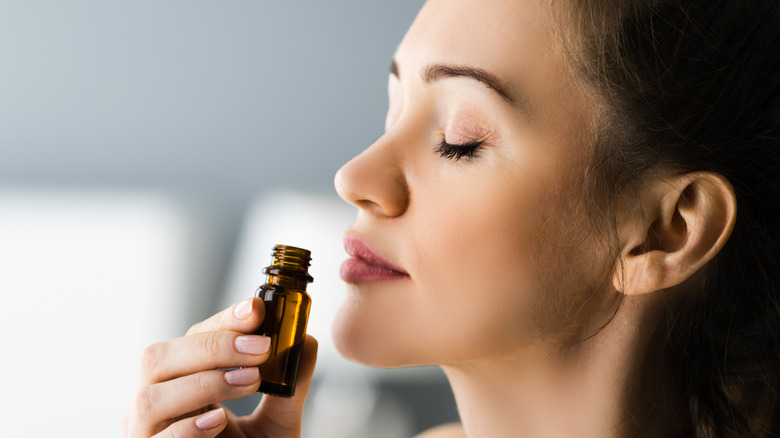20 Ways To Naturally Get Rid Of Headaches
If you suffer from headaches, know that you're not alone. In fact, headache disorder is one of the most common health conditions on the planet, according to a recent Global Burden of Disease (GBD) study (via a 2022 paper published in The Journal of Headache and Pain). Because headaches have so many possible causes, it can be helpful to identify the cause of yours before deciding how to treat them (via Mayo Clinic).
For example, aspirin may be appropriate for some headaches, but for others, it won't make a difference. Likewise, some headaches respond well to alternative therapies. For example, tension headaches may be managed through cognitive behavioral therapy. In other cases, an underlying disease or condition may be causing a headache, in which case addressing the underlying disease or condition may be the solution. And some headaches have no apparent cause at all.
In all cases, while you're trying to figure out what's causing your discomfort, you might wish to consider one of these 20 alternative/complementary natural headache remedies.
Medical marijuana
Medical marijuana refers to any drug derived from the Cannabis sativa plant that has been legalized for medical use in 47 U.S. states and the District of Columbia and/or by the federal government. Other than that, and with the exception of decriminalized recreational use in some of these states, medical marijuana is still illegal under federal law, no matter which state you reside in. All of that said, if you have headaches, medical marijuana could provide you with some level of relief according to a 2021 review of existing scientific studies published in Cureus.
First, medical marijuana may help to alleviate pain according to the aforementioned review authors, who noted that medical marijuana users seemed to need less pain medication for their headaches. Second, medical marijuana use is also associated with increased feelings of well-being. Moreover, a 2022 study published in Frontiers in Neurology demonstrated that marijuana use can allow for longer time between migraine attacks and shorter attacks overall.
Citron
The citron, or Citrus medica, is a citrus fruit native to some Mediterranean countries, according to Britannica. Although the citron may look like a cross between an orange (because of its spherical shape) and a lemon (because of its bright-yellow, dimpled rind), it's distinct from both. Rich in antioxidants such as phenolics, flavonones, and vitamin C, among others, citron has shown promise as a nutraceutical in support of the circulatory, cardiovascular, digestive, and metabolic systems. It's also known for its analgesic (pain-killing) properties, which is where it could come in to help provide natural relief for headache pain.
Indeed, citron syrup is a traditional Persian remedy for headache pain, according to a 2016 study published in the Journal of Ethnopharmacology. That study confirmed that when consumed as a syrup (by boiling the flesh and rind with sugar and water), citron helps decrease migraine pain, with an effectiveness level comparable to the beta blocker, propranolol.
Foot reflexology
Foot reflexology, acupressure, and acupuncture are all holistic practices, meaning they're natural, non-invasive therapies. Each is aimed at optimizing overall wellness by encouraging the free flow of energy (i.e., qi) throughout the body, according to Natural Healers. All are believed to provide headache relief by stimulating various trigger points throughout the body that are associated with headache pain. Foot reflexology, in particular, involves applying manual pressure to such points on the feet (via the University of Minnesota). A 2017 study published in the Journal of Traditional Chinese Medicine confirms that foot reflexology may help relieve headaches. This study concluded that reflexology could offer a safe and effective alternative to pharmacological migraine therapies.
For best results, you may wish to see a professional foot reflexologist. But if you want to try it at home, you can start by applying fingertip pressure to the space between your big and second toes for headache pain that emanates from behind the ears. Pressure applied to the small toes and the nail beds of the large toes can ease headache pain emanating from the sinuses.
Acupressure
In acupressure, the trigger points are not limited to the feet, but, rather, are located around the body, according to Memorial Sloan Kettering Cancer Center (MSKCC). Like reflexology, acupressure has been shown to help reduce headache pain, per a 2010 study published in the American Journal of Chinese Medicine. In that study, 28 chronic headache sufferers were randomized into two study arms. One received acupressure therapy for one month; the other was given muscle relaxants. Based on self-assessment of the subjects, the study found that pain was more effectively controlled in the acupressure group than in the group that took muscle relaxants. Moreover, this phenomenon continued for at least six months after treatment ended.
One acupressure point that may help relieve headache pain is located on the back of the hand, between the base of the thumb and index finger, according to MSKCC. Pressure should be exerted using the thumb and forefinger. However, you may have better results with a practitioner certified by the American Organization for Bodywork Therapies of Asia, according to Natural Healers.
Acupuncture
In acupuncture, trigger points throughout the body are stimulated by slender needles (via BMJ). Like reflexology and acupressure, acupuncture has been proven effective in reducing headache pain. A 2008 study published in the journal Cephalalgia found the addition of acupuncture to regular medical care in people with headaches is associated with improved outcomes, compared with regular medical care, alone. A 2016 review of 22 existing clinical studies on the efficacy of acupuncture as a treatment for headaches, found, specifically, that the addition of acupuncture to treatment for headache symptoms, can reduce the frequency of headaches. In addition, a 2019 study published in the journal Neuropediatrics found acupuncture is a safe and effective adjunct headache treatment for children.
To find an acupuncturist who is also a medical doctor, look for individuals who have accreditation with the American Board of Medical Acupuncture (ABMA) or the American Academy of Medical Acupuncture. However, an acupuncturist need not be a physician. If you decide to go the non-physician acupuncturist route, The Washington Post recommends finding one who has been certified by the National Certification Commission for Acupuncture and Oriental Medicine (NCCAOM). You'll recognize them by the Dipl. Ac in their title.
Yoga
Yoga is an ancient practice that takes various forms, but what all have in common is a focus on the breath while the body performs various poses, presumably barefoot. One reason yoga has been around for as long as it has is that it has the power to make people feel better, according to the National Center for Complementary and Integrative Health (NCCIH), which points out that in addition to the physical benefits, yoga can promote mental and emotional health, healthy eating habits, and better sleep.
The NCCIH also notes that a 2019 study offers preliminary evidence that yoga offers yet another natural headache remedy. Published in the Journal of General Internal Medicine and comprised of a meta-analysis of existing relevant research, the study observed that yoga decreased headache frequency, length of headache, and the intensity of headache pain in people for whom tension-type headaches are an issue. The study authors say that this will have to be confirmed via large-scale randomized, controlled trial. However, in the meantime, it might be worth noting that Excedrin recommends yoga for headache relief.
Aerobic exercise
Like yoga, aerobic exercise involves movement that is connected, by definition, to the breath. In fact, aerobic actually means, literally, "with oxygen" (via the Cleveland Clinic). Unlike yoga, however, in aerobic exercise, you don't have to be conscious of your inhales and exhales to reap the benefits. Rather, you just have to engage in physical activity that raises your heart rate enough to have you breathing noticeably heavier than you would be at rest — but not so heavily that you can't maintain the activity for an extended period, according to Polar Blog, which actually uses the words "for hours," in place of "extended period."
Now, you may have heard that aerobic exercise can trigger a headache. That is, in fact, true. Nevertheless, it's also true that aerobic exercise can make you feel better when you have a headache, according to a 2018 study published in Cephalalgia. Moreover, regularly participating in aerobic exercise can reduce the frequency of migraine headaches, as well as their duration. A 2019 meta-analysis published in The Journal of Headache and Pain confirmed the same with regard to headache duration.
Feverfew capsules
Feverfew is a daisy-like flower that has been used for medicinal purposes since ancient times — often in the form of crushed flowers and leaves (which now come in capsule form). Although feverfew got its name because medical practitioners once believed that it helped bring down fever, it turns out that feverfew is better known for its effects on pain and inflammation, according to Mount Sinai. Moreover, it has a particularly good track record with regard to treating and preventing migraine headaches, according to several studies.
That said, results may vary depending on individual physiology as well as the particular formula and dosage used. A 2011 paper published in Pharmacognosy Reviews recommended 100 to 300 mg. up to four times per day for the prevention and treatment of migraines. However, since feverfew may interact with some medications, including blood thinners, it would be wise to check with your healthcare provider before starting feverfew capsules for headache relief.
Sex
See the couple in the photo above, looking all comfy and happy as they loll about in the smooth white sheets? You'd never know from looking at them that not even 20 minutes ago, they were both complaining of splitting headaches. Fortunately, they both work from home. Even better, both also happen to have heard that sexual activity is a handy weapon in the natural headache remedy arsenal. In fact, a 2013 study published in Cephalalgia, which surveyed 1,000 headache sufferers about their experience of having sex during a migraine or cluster headache attack, concluded that "sexual activity can lead to partial or complete relief of headache in some migraine and a few cluster headache patients."
If only more people wanted to have sex while dealing with a migraine or cluster headache. On the other hand, you might want to also keep in mind that sexual activity, itself, has also been known to cause the occasional headache. Further, people prone to migraines are more prone to sex headaches, although sex headaches are clinically distinct from migraines.
Cupping
Cupping therapy is another holistic medical technique has been used since ancient times to promote well-being and reduce physical pain, including headaches. Like acupuncture, acupressure, and reflexology, cupping therapy is aimed at facilitating the optimal flow of energy (i.e., qi) throughout the body for the purpose of promoting optimal health and natural healing. In cupping therapy, this is achieved through the placement of small, heated cups — open side down on the skin — at various acupuncture points, as trigger points are sometimes referred.
As the cups cool, a vacuum is created, which draws blood toward the surface of the skin, thereby increasing blood flow, according to a 2020 paper published in the Journal of Alternative and Complementary Medicine. In wet cupping therapy, the skin is actually pierced, with the result being that blood, and presumably toxins, get drawn out of the body (via Cleveland Clinic). A 2019 study published in the Oman Medical Journal suggests that wet cupping therapy, in particular, may be a viable complementary treatment for migraine headache pain. A 2021 review of relevant medical literature concurs but also notes that more research is needed.
Caffeine
If you've ever come down with a pounding headache after skipping your morning caffeine jolt, then you may already have an inkling that caffeine withdrawal can trigger a headache. To the extent that your headache is caused by caffeine withdrawal, consuming something caffeinated can bring almost instantaneous relief. However, even if you're not in caffeine withdrawal — and particularly if you're not already addicted to caffeine — moderate caffeine consumption can ease headache pain, according to a 2008 paper published in Current Pain and Headache Reports).
As the Mayo Clinic explains, caffeine has vasoconstrictive properties, which means that it causes blood vessels to narrow, temporarily. This can provide relief during a headache because headaches are associated with the swelling of blood vessels and an increase in blood flow to the brain. In addition, caffeine taken in combination with a pain reliever helps the pain reliever to do its magic more quickly and efficiently.
Hydrating
The human body is composed of somewhere around 70% water. That water needs constant replenishment, according to the Mayo Clinic, which defines dehydration as being in any state of deficit with regard to water replenishment, however mild. Of course, dehydration can lead to headache.
Accordingly, if you feel a headache coming on, you might want to ask yourself is if you've been consuming enough water. But, in any case, it probably wouldn't hurt to help yourself to a glass. If your headache is the result of dehydration, then it will likely improve if you drink water. On the other hand, your headache might improve more quickly if you take an aspirin or other pain reliever with your water. Of course, there are times when that may not seem ideal, such as during pregnancy. That's why hydrating is one of the safest first steps you can take to treat a migraine during pregnancy.
Meditation
Meditation is the process of observing one's thoughts without attaching meaning or judgement to them. While this can certainly be accomplished while sitting, it can also be accomplished while engaged in any simple activity that doesn't demand complicated decision-making or analysis. Moreover, although meditation can involve focusing on, say, a flickering candle, guided imagery, or a mantra of some kind, it doesn't have to. As long as you're trying to observe your thoughts with equanimity and without attachment, you're meditating. And one of the benefits of meditation is that it's associated with natural pain relief, including relief from headache pain.
How this works is not entirely clear to scientists. According to Healthline, research suggests that the neural pathways utilized by the brain in meditation trigger the brain's release of substances that act as analgesics in the body. On the other hand, a 2015 study published in Behavioral Medicine suggests that certain types of meditation may not reduce pain so much as increase one's tolerance to pain.
Magnesium supplementation
Magnesium is an essential mineral for the human body. However, many Americans do not get enough, and that could be giving you a headache, according to a 2020 study published in Nutrients. Although there aren't too many symptoms of mild magnesium deficiency in the short term, chronic magnesium deficiency — even chronically mild — raises the risk of high blood pressure, along with all the risks associated with high blood pressure. On the other hand, one early sign of magnesium deficiency is headache.
In fact, up to half of all migraineurs may be living with some degree of magnesium deficiency, according to the authors of a 2012 study. Indeed, a small but randomized, controlled, and double-blind 2021 study published in Acta Neurological observed that as little as 500 mg of daily magnesium daily supplementation reduced frequency and duration of migraines as effectively as the FDA-approved anti-migraine medication valproate sodium.
Magnesium supplements are readily available over the counter. Because magnesium may interact with some medications, it's advisable to check with your healthcare provider before getting started with magnesium supplementation.
Reiki
Reiki is another holistic therapy that has been associated with headache relief. Reiki is a lot newer than some of the others, however, having been developed in Japan at just the turn of the 20th century. Like acupuncture, acupressure, foot reflexology, and cupping therapy, Reiki is premised on the notion that energy must flow freely throughout the body for optimal wellness and healing. In Reiki, the practitioner uses gentle touch to encourage that flow.
The International Association of Reiki Professionals acknowledges that, thus far, no clinical study has established that Reiki can treat headaches. However, existing studies indicate that Reiki can reduce stress, which the Association notes can be a precursor to migraines. Further, Reiki can improve mood, which can put one in a better position to cope when migraine strikes. Finally, studies suggest that after people have a reiki session, they report feelings of reduced pain.
Bowen therapy
Every muscle and organ in your body is encased in fascia, according to Johns Hopkins Medicine. Fascia, a form of connective tissue, is there to hold everything in its proper place. To accomplish that even while the human body is in constant motion, fascia is loaded with nerves. Connected as it is to the nervous system, fascia can tighten painfully in the face of physical or emotional stress. This can, in turn, lead to pain, including headache, especially when the fascia of the neck is involved.
Bowen therapy is a therapeutic form of massage, aka bodywork, which involves the gentle manipulation of fascia. The technique was developed in the 20th century by Thomas Ambrose Bowen, who claimed that it could not only relieve imminent pain, but it could also reboot how the body reacts to pain. While there's little scientific data that specifically tends to corroborate Bowen's claim, anecdotal evidence suggests there may be something to it, according to Medical News Today and a 2011 paper published in the Journal of Alternative and Complementary Medicine.
Chiropractic
Although chiropractors are often addressed as doctors, they aren't actually medical doctors. That said, chiropractors are trained and licensed to perform chiropractic therapy, which consists of the diagnosis and treatment of neuromuscular disorders through laying of hands on the body and manipulation of the joints and spine.
According to the American Chiropractic Association, research indicates that chiropractic therapy can be an "effective treatment option for tension headaches and headaches that originate in the neck." Specifically, a 2011 paper published in the Journal of Manipulative and Physiological Therapeutics, which compiled the results of 21 relevant clinical studies concluded that chiropractic care that includes spinal manipulation is an effective treatment for both migraines and for headaches caused by neck misalignment (aka cervicogenic headache).
Ayurveda
Ayurveda, which means "knowledge of life," refers to an ancient natural system of medicine. Ayurveda is premised on the notion that the body is comprised of separate life forces (i.e., doshas) that must remain in balance for optimal health and wellness. In India, Ayurveda is considered to be as legitimate as Western medicine, which, itself, is seen as equal to naturopathy, homeopathy, and traditional Chinese medicine. That said, there is no standard for Ayurvedic certification in the U.S. In other words, Ayurveda isn't currently regarded as more than a complementary therapy.
Nevertheless, Ayurveda experts such as Dr. Dhanvantri Tyagi firmly believe that Ayurveda offers some of the best natural remedies for headache (via NDTV Food). These include head massage, hydration (sounds familiar, no?), and regular use of a neti pot to cleanse the nostrils and upper airways so as to ensure better breath flow. In addition, placing a few drops of oil derived from the herb, brahmi, into the nostrils, may ease headache pain. So too drinking warm water infused with a pinch of rock salt. Many other ayurvedic headache treatments may also be appropriate, depending on your dominant dosha.
Aromatherapy
Aromatherapy refers to the centuries-old practice of taking in the scent of various essential oils (highly concentrated plant-based oils diluted in a carrier oil such as coconut, almond, or olive for their therapeutic properties. "When inhaled, the scent molecules in essential oils travel from the olfactory nerves directly to the brain and especially impact the amygdala, the emotional center of the brain," Johns Hopkins Medicine explains.
A 2008 study published in the Journal of Korean Academic Society of Nursing Education found that aromatherapy could, in fact, "be an effective nursing intervention in relaxing and relieving the pain caused by tension-type headache for students." For that study, 44 students were divided into two groups. One group received aromatherapy massage every other day for three weeks. The other group received no intervention. What the data revealed is that the aromatherapy group had fewer/less severe headaches, as well as lower measures of the stress hormone, cortisol.
Healthline identifies five essential oils that may offer headache relief when used in aromatherapy. These are lavender, chamomile, rosemary, peppermint, and eucalyptus. Please note that essential oils are not monitored by the FDA, so you'll want to make sure to obtain your essential oils from a reputable manufacturer.
The hair of the dog remedy for a hangover headache
If your headache is part of an overall hangover you're experiencing in the aftermath of consuming alcohol, perhaps you've already discovered that hydration and caffeine go splendidly with aspirin and other over-the-counter analgesics. But perhaps as brunch calls, you can't help but feel curious about whether you'd be better off turning to "the hair of the dog that bit you." The old expression refers to the practice of drinking more alcohol to alleviate the headache and other hangover discomfort.
According to the Oxford Dictionary of Word Origins, the expression derives the old belief that if you are bitten by a rabid dog, then consuming a potion made from the rabid dog's fur can cure you. To be clear, it cannot. However, the metaphorical hair of the dog can actually deliver some instant headache relief if you're staring down the business end of a hangover. The most imminent risk is that you may be trading in a hangover now for a hangover later. Other risks include increasing your likelihood of becoming alcohol dependent. For a really intractable hangover, you may be better off with IV therapy.
If you or anyone you know is struggling with addiction issues, help is available. Visit the Substance Abuse and Mental Health Services Administration website or contact SAMHSA's National Helpline at 1-800-662-HELP (4357).
